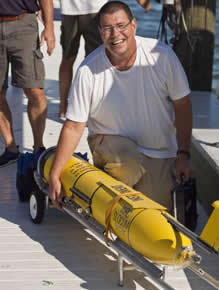
Dr. Gary Kirkpatrick with the autonomous underwater vehicle nicknamed "Waldo."
A robot that was AWOL last week from its red tide patrol in Southwest Florida resurfaced at 6:06 a.m. Thursday and once again began signaling its position to Mote scientists.
Mote staff didn't waste a minute before hopping in a boat and recovering the robot, called an autonomous underwater vehicle, or AUV for short. "We're thrilled to have Waldo back," said Dr. Gary Kirkpatrick, inventor of the payload the AUV carried to detect red tide. "It's our only AUV currently patrolling for red tide, and it's crucial for studying algae blooms."
Waldo, the AUV nicknamed for the popular cartoon character from the "Where's Waldo" series, was found about 50 feet from the last place it was tracked, about 11 miles west of Venice. The robot was listing slightly to one side, but the researchers have yet to discover why it lost touch with satellites.
"We think it's possible that it was snagged on something underwater," Kirkpatrick said. "But we'll need to check the data it was collecting to see if that helps shed some light on what happened."
The robot had been patrolling Southwest Florida waters since Aug. 26 carrying a BreveBusterTM, a device designed by Kirkpatrick and built at Mote to automatically detect red tide in the water column. Waldo was supposed to report its position to Mote scientists via satellite each time it surfaced - about every two hours. But as it glided along on Aug. 31 near Venice, it stopped sending signals.
Mote scientists searched for the 115-pound, canary-yellow robot for more than 10 days using side-scan sonar, VHF, hydrophones, airplane surveys, snorkelers and divers. When Waldo lived up to its nickname by proving extremely difficult to find, the scientists even put a call out to the public for help.
"It's funny, we really worked the spot where Waldo was eventually found," Kirkpatrick said. "There's a lot of marine snow, algae and a lot of moon and comb jellies there when we had divers in the water. Those factors may all have played a role in why we couldn't locate the AUV once it had gone missing."
Waldo — valued at $100,000, plus another $30,000 for its red tide detector — has been "on the job" for Mote since 2005, through a grant from Florida's Fish and Wildlife Conservation Commission (FWC). Mote scientists added two identical robots, Nemo and Carmen, in 2006 through a grant from the National Oceanic and Atmospheric Administration (NOAA). But the latest project for these two robots has ended, and they currently have no funding to replace Waldo.
While given a tongue-in-cheek nickname, Waldo has a pretty serious job patrolling for Florida red tide, which can kill or sicken sea animals and birds and cause respiratory ailments in humans.
The information the AUV transmits back to researchers in the lab is important to helping us unlock how red tides begin, where they travel and what eventually causes a bloom's demise. Since it's too expensive to send researchers out on boats to patrol for red tide 24 hours a day, seven days a week, the job has been turned over to robots like Waldo. Using AUVs and BreveBusters has helped scientists show that phytoplankton — the group of microscopic organisms that the red tide belongs to — are very unevenly distributed in the waters off the coast of Southwest Florida. That makes Karenia brevis, the organism that causes Florida's red tide, difficult to locate and even harder to forecast.
